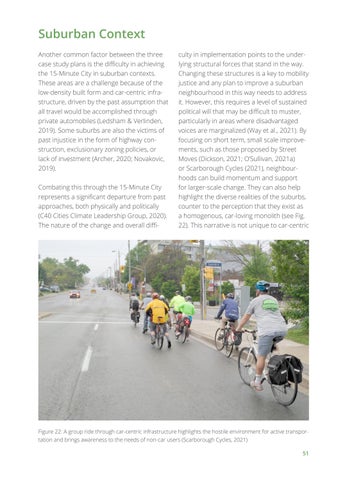Suburban Context Another common factor between the three case study plans is the difficulty in achieving the 15-Minute City in suburban contexts. These areas are a challenge because of the low-density built form and car-centric infrastructure, driven by the past assumption that all travel would be accomplished through private automobiles (Ledsham & Verlinden, 2019). Some suburbs are also the victims of past injustice in the form of highway construction, exclusionary zoning policies, or lack of investment (Archer, 2020; Novakovic, 2019). Combating this through the 15-Minute City represents a significant departure from past approaches, both physically and politically (C40 Cities Climate Leadership Group, 2020). The nature of the change and overall diffi-
culty in implementation points to the underlying structural forces that stand in the way. Changing these structures is a key to mobility justice and any plan to improve a suburban neighbourhood in this way needs to address it. However, this requires a level of sustained political will that may be difficult to muster, particularly in areas where disadvantaged voices are marginalized (Way et al., 2021). By focusing on short term, small scale improvements, such as those proposed by Street Moves (Dickson, 2021; O’Sullivan, 2021a) or Scarborough Cycles (2021), neighbourhoods can build momentum and support for larger-scale change. They can also help highlight the diverse realities of the suburbs, counter to the perception that they exist as a homogenous, car-loving monolith (see Fig. 22). This narrative is not unique to car-centric
Figure 22: A group ride through car-centric infrastructure highlights the hostile environment for active transportation and brings awareness to the needs of non-car users (Scarborough Cycles, 2021) 51






